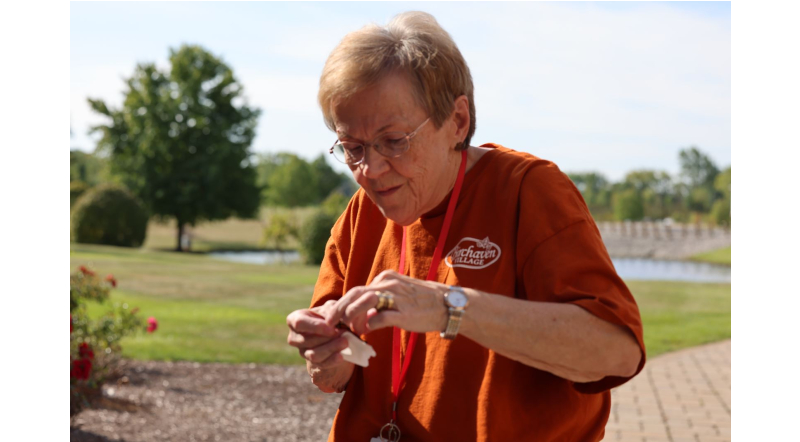Birchaven Village Residents Raise Butterflies
(From Blanchard Valley Health System)
Residents of Birchaven Village, a division of Blanchard Valley Health System, have been getting a close-up look at nature this year through a new project involving raising monarch butterflies. They begin by caring for eggs and continue until they release the adult butterflies to take flight for the first time.
Ruthann Hahn, volunteer coordinator, has been teaching residents of the Heights at Birchaven about the butterflies. She came up with the idea after bringing her young great-granddaughter last year to speak to residents and show them a butterfly she had raised at home.
“Our residents are always so interested in learning,” Hahn said. “Life gets busy and maybe, when they were younger and raising children, they never had the chance to learn much about butterflies. Getting to see the life cycle up close and personal has been a delight for so many of them.”
In fact, throughout the process, residents have stopped by to check the progress of the eggs and caterpillars, she said. Residents have been heard talking about it over dinner or bingo. The project has even brought some residents who previously kept more to themselves to talk with neighbors about their shared love of the butterflies.
Hahn, inspired by her granddaughter and great-grandchildren, has been growing milkweed at her own home for years. Butterflies lay their eggs on milkweed. Once the tiny black eggs hatch, Hahn puts them in a small plastic tub where the pupa becomes a caterpillar. She then puts it in a small net house, with live milkweed to eat. The caterpillar spins a cocoon and, in time, a butterfly emerges. The Birchaven residents have been giving them a day for their wings to dry, then releasing them.
The butterfly spends about 12 days in the cocoon, which starts out green but turns dark in color over time.
“It’s so interesting to learn about them,” said Jane Brown, a resident of the Heights. “We knew one was getting close to coming out, so I was checking every day.”
Brown didn’t get to see the moment the butterfly emerged from the cocoon, remarking that “I guess it wanted privacy.” However, she had enjoyed learning throughout the experience.
“This has been so much fun for us to watch,” she said.
Before releasing the latest butterfly, Hahn explained that the patterns of dots on a monarch butterfly’s wings are different for males than for females. This butterfly was a female.
Hahn carefully affixed a tracking sticker to the butterfly’s wing before placing it on a flower outside the building. The butterfly sat for a moment, then took off, soaring above the three-story building.
After the butterfly flew away, Brown noted that some remnants of the cocoon were still visible.
“Isn’t it wonderful?” she said.
Each sticker has a unique number identifying this individual butterfly with the organization Monarch Watch. When the butterfly heads to Mexico, where they typically migrate, people there can look it up and learn that that particular butterfly hatched in Findlay.
Hahn’s granddaughter is active in a Facebook group where people track the butterflies that have been tagged. She registers the stickers into the system, so people can follow these individual butterflies. Hahn said people all over the United States and Canada have been raising butterflies for Monarch Watch.
Hahn said the goals of this project were to help residents continue to learn, as well as generally improving their quality of life.
“And it’s so beautiful, too,” she added. “Seeing a butterfly take its very first flight, and knowing someday that same butterfly might end up in Mexico – there’s nothing quite like it.”
For more information about Birchaven Village, please visit www.birchaven.org .

